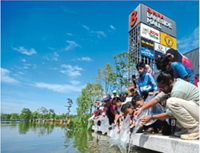AFTER the United Nations (UN) COP28 (Conference of Parties) climate conference drew to a close in Dubai on Dec 13 last year, a few key outcomes got the world’s attention.
Many observers zoomed in on the portion of the COP28 text that called on countries to transition away from fossil fuels in energy systems, hailing the conference as the first COP to officially acknowledge that fossil fuels are the root cause of climate change.
The target for countries to triple renewable energy generation capacity by 2030 was also in the spotlight, as was the call for countries to double energy efficiency improvements by the same timeline.
Yet, throughout the two-week conference, many other issues were also discussed – such as the impact of climate change on food supplies, the role of nature in climate action, climate finance, and so on — all of which will affect how nations respond to the planetary emergency.
While increasingly used as a platform for announcements or launches, the UN climate conferences are primarily an exercise in international climate policy-making and diplomacy.
Negotiators from almost 200 countries gather every year to hash out an international agreement for how countries can work together to translate the goals in the Paris Agreement, the world’s climate pact adopted in 2015, from targets into action.
Targets in the Agreement include limiting global warming to “well below” 2°C, preferably 1.5°C, above pre-industrial levels; taking steps to deal with the impacts of climate change; providing support for developing countries in the green transition, as well as increasing the ability of countries to report progress in these areas.
Developments at these conferences will have cascading impacts on geopolitics and national policies.
Scaling ambition
COP28 saw an unprecedented turnout of some 80,000 people – almost double the number who attended COP27. One reason why this summit was so closely watched was because it marked the conclusion of the first global stocktake.
Under the Paris Agreement, the global stocktake is meant to be undertaken once every five years. During the two-year process, multiple stakeholders, including countries, businesses and civil society come together to assess how far the world has come at meeting the goals of the Paris Agreement. The aim is to provide the chance for course correction based on the latest available knowledge.
To meet the goals in the Agreement, countries set targets – called nationally determined contributions (NDCs) – which outline what each is doing to take action against climate change. New or updated NDCs are due every five years, and each one is supposed to be more ambitious than the last. So far, countries have submitted new or updated NDCs in 2015 and 2020.
The first global stocktake process found that despite the NDCs, the world has fallen short in all areas, and that much more is needed to be done to limit warming, adapt to climate change impacts, and provide support for developing countries. It also came up with possible solutions. At COP28, countries agreed on a “roadmap” to help countries set more ambitious climate targets.
This included the call for countries to transition away from fossil fuels in energy systems, boost energy efficiency, triple renewable energy capacity, and so on. The decision also outlined ways that societies can improve climate resilience, by urging countries to conduct up-to-date assessments of climate hazards, as well as formulate and implement plans to protect people from climate impacts.
The next round of NDC submissions is due in 2025. At COP28, it was agreed that countries must provide information on how the preparation of their updated targets was informed by the outcomes of the global stocktake.
This clause could help ensure that the new round of pledges are, at the very least, guided by the “roadmap”, which references the key focus areas of tackling climate change, including the need to transition away from fossil fuels in energy systems. If countries do not do so, their non-compliance can be flagged by the Paris Agreement Implementation and Compliance Committee, which was set up to ensure that parties comply with the legally binding treaty.
These developments point to a few ways that South-East Asia can do more to reduce emissions and prepare for climate impacts.
Renewable energy
The COP28 outcome signals a need for South-East Asian nations to think beyond borders when it comes to climate action.
For one, the developing region has an insatiable appetite for power – a 2019 report by the International Energy Agency showed that the bloc’s energy demand is expected to increase by 60 percent by 2040 due to rapid economic growth, growing population and rising incomes.
At the same time, pressure is also mounting on all countries, including both developed and developing nations, to move away from burning fossil fuels for energy generation.
One of the most promising ways for the region to meet its energy needs in a low carbon way could be through the establishment of a regional power grid. Currently, each country in the region operates and regulates its own grid.
Professional services firm PwC, in a 2022 report on regional electricity trade in Asean, noted that an integrated grid could help lower costs and allow countries with resources – including renewable energy sources, such as the sun or wind – to supply green energy to countries with less resources, making energy distribution more optimal.
While talks of such a grid have been ongoing for over a decade with no real progress, there have been encouraging developments on this front recently.
In June of 2022, the first multilateral cross-border electricity trade involving four Asean countries kicked off, with Singapore importing electricity generated by hydropower dams in Laos through Thailand and Malaysia.
The COP28 outcome, which also called on countries to do more to “phase-down unabated coal power” (this refers to coal plants that are not outfitted with still-nascent technologies to capture carbon emissions), coupled with stricter bank lending schemes that have stopped financing new coal plants, could accelerate greater progress in this area.
While the COP28 outcome stopped short of providing details on finance for renewable energy projects and related infrastructure, there were parallel discussions at the conference about other forms of financing, including the role of the private sector and multilateral banks.
For example, the Monetary Authority of Singapore at COP28 proposed the creation of “transition credits”, which can be generated when coal-fired power plants are retired early and replaced with cleaner energy sources. This will provide the funds to compensate coal plant owners for income lost from the early closure of their plants.
Discussions on climate finance are expected to continue at COP29, to be held in November this year in Baku, Azerbaijan.
Banking on nature
At COP28, discussions on the role of nature in climate action continued to be as pronounced as in the preceding two climate conferences (COP26 and COP27), with texts from various negotiation tracks referencing the interlinkages between biodiversity loss and climate change.
Given South-East Asia’s rich natural heritage, there is scope for the region to continue banking on its forests, mangroves and wetlands for climate action while protecting its biodiversity. Tropical forests, for example, can help to draw down planet-warming carbon dioxide from the atmosphere through photosynthesis, while mangroves can help protect coastal communities from rising sea levels and storm surges.
Financing for nature conservation has always been a challenge.
Yet, with the growing recognition of the need to harness nature in the fight against climate change, the UN climate conferences have helped to channel resources for this purpose. For instance, at COP26 in Glasgow, countries agreed on a broad framework that will allow carbon credits to be used to meet national climate targets.
This helped to create a new financing mechanism for forest conservation. For example, by restoring a degraded forest or protecting it from being cut down, land developers can sell carbon credits from the emissions savings to an emitter elsewhere, who can use the credits to offset its emissions.
The framework that allows for the global trade in carbon credits was agreed on at COP26, but details were left to future COPs to figure out. At COP28, however, no conclusion was reached on some of the residual issues, such as what types of projects could qualify as sources of credits, and on the development of an international registry that could prevent carbon credits from being claimed by more than one party.
This lack of agreement would likely delay the implementation of carbon projects, including conservation-based ones, as countries adopt a wait and see attitude in response to changing policies.
But COP28 also saw discussions on other innovative new financing schemes to protect nature, such as debt-for-nature swaps in which sovereign debt of a developing country is cancelled in exchange for nature conservation measures.
What is clear is that the protection and restoration of nature is now a key element of the climate negotiations and will continue to feature in these discussions going forward.
South-East Asia is one of the regions of the world most vulnerable to the impacts of climate change.
Home to over 660 million people, many of them living on the coast, the region will bear the brunt of escalating climate impacts from typhoons, rising sea levels and other climate disasters.
But leveraging on its rich natural resources and bounty of renewable energy sources, South-East Asia can also contribute to global efforts to keep its inhabitants safe.
The latest scientific reports by the UN’s climate science body, the Intergovernmental Panel on Climate Change, have highlighted that when it comes to tackling the climate crisis, no one is safe until everyone is safe.
The science is clear, and the international climate negotiations have provided a framework for global climate action. Now, it is time for governments to act.
Audrey Tan is a former environment journalist at The Straits Times in Singapore, and is currently the science communications and outreach lead at the National University of Singapore’s Centre for Nature-based Climate Solutions (CNCS). Melissa Low is a research fellow at CNCS who studies international climate change negotiations. She is a long-time observer of the UN climate change conferences.
The views expressed here are the writers’ own.









